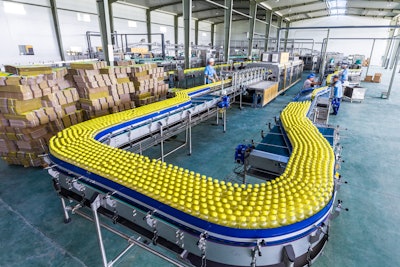
By this point in the global pandemic, most consumers have seen the empty grocery store shelves and likely felt the pain of seeing those “temporarily out of stock” signs on food items needed to complete a recipe. Many of these supply chain issues are a result of a crippling labor shortage hitting food manufacturers, and there is no clear end to this crisis on the radar.
After analyzing recent Bureau of Labor Statistics’ data, the Consumer Brands Association (CBA) reports the consumer packaged goods industry has an estimated 130,000 unfilled jobs.
Leading companies are combating the labor shortage by implementing automation that creates efficiencies by streamlining workflows, reconfiguring workspace layouts and reducing the number of people needed to manufacture food and beverage products.
For example, logistics companies are investing in robotics within the supply chain (i.e. warehousing, conveyor systems, pick and place, packaging, etc.). Technology, such as artificial intelligence (AI) and enterprise resource planning (ERP) software systems will help alleviate supply chain issues. Companies are also turning to efficiency audits that access operational workflows and then recommend technology that will allow them to do more with fewer people.
But, modern technology and automation can be quite an investment. For that reason, many growth-oriented food manufacturers choose to finance their equipment, including food manufacturing and processing machines, material handling equipment and warehousing systems, as well as energy and sustainability projects, which allows them to reap the benefits of state-of-the-art equipment without a large cash outlay.
Types of equipment financing solutions
Financing should be structured to meet each organization’s objectives and goals. Structures include:
Equipment lease. Leasing equipment allows food manufacturers to preserve working capital and lines of credit for other business investments. Any payments required by the vendor may be made by the lender on behalf of the customer. Manufacturers also gain flexibility, as payments can be designed to match budget requirements and terms aligned with the equipment’s useful life.
Leasing equipment also offers potential obsolescence and depreciation protection, with the ability to add or upgrade equipment during the lease term.
Asset finance. One hundred percent financing includes bundling the equipment with soft costs (i.e. installation, sales tax, freight and maintenance). With this option, processors acquire what they need to manage their business, typically with no advanced payment and one fixed monthly payment. Compare this to a 75% loan-to-value term loan financing, and the advantage is clear.
Customized financial solution. Equipment financing may provide tax advantages. A carefully structured financing plan can maximize equipment depreciation and tax credits while minimizing income tax liabilities.
Not all food manufacturers can utilize the full tax depreciation of their equipment assets. Leasing with a strong financing partner can unlock additional depreciable value in the form of lower payments.
Top considerations when choosing a financing option
When financing the acquisition of processing, packaging and transportation equipment and systems, there are several aspects for food manufacturers to consider, including return on investment (ROI), weighing the structure and choosing your lending team.
Assess the ROI. ROI will vary depending on whether the equipment is an upgrade or added to increase lines of business. Also, consider how the equipment will impact business operations, and how long newly acquired assets will need to be in production before the business realizes savings or revenue. Lenders should provide guidance related to the equipment’s residual value and useful life, which are key in determining a sound financing solution.
Evaluate details of each financing option. The business owner should have a clear understanding of the lease conditions, including term, monthly payment and end-of-term options, as well as flexibility for paying the lease off early, upgrading technology and adding equipment under the particular agreement. Also, examine the soft costs and whether or not they can be financed. Determine if the lease can be renewed and know how liable the business owner is if the equipment is damaged or destroyed. Learn of any additional fees that will be due during or at the end of the financing period.
Fixed rates and rate locks are important considerations, especially this year, because the Federal Reserve has indicated it plans to raise interest rates, likely several times. Locking in lower fixed rates will be a valuable tool to save interest costs. Some equipment term lenders are able to lock in rates today for equipment purchases in the future, also known as Rate Lock programs. Know your lender’s capabilities.
Select a financing team. The right financing team should provide all the information needed to consider all available tools and make a wise decision to acquire the equipment a business needs to stay competitive in this rapidly changing industry. Business owners should be bold in asking their potential financing provider the tough questions so they can truly evaluate and select the ideal team. For example:
· Do they understand my business and how this transaction needs to be customized to meet my business requirements?
· Do they make time to listen to me?
· Do I feel like this financing provider wants to see my business succeed, and will guide me through the entire process?
· Can they accommodate my needs for customized payments to match my budget?
· Is this a well-established finance team that has survived economic ups and downs, and are they experienced in financing food manufacturing equipment?
As an added plus, aligning with the right financing provider and terms may allow businesses to use cash reserves elsewhere. Using financing to invest in technological and related resources to safely increase productivity and gain a competitive advantage in a tight labor market can be key to longevity.





















